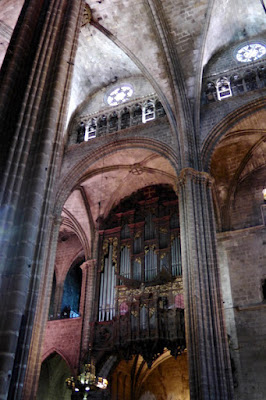We got up rather early as we rested after the second Fado show to avoid seasickness. The ocean was fairly calm so we were ready for breakfast and were anxious to attend an enrichment lecture on marine biology presented by Dr. Jay Christofferson, PhD. He is a retired professor from UC Stanislaus and you could tell that he was teaching for a long time as his lecture was organized, humorous, and very informative to people with little background in marine biology. He definitely stimulated me to learn more about this fascinating portion of the earth sciences.
Following Dr. Christofferson's lecture, Gregory Bowden presented a lecture entitled "All About Champagne." Since Earline and I have visited the Domaine Chandon winery inn Napa, California, we were pretty familiar with the process of making a sparkling wine. However, you can always learn something, especially from a wine expert.
The Champagne region of France is in the northeast portion of France. The sparkling wine produced in this region is the only wine that can bear the title of a Champagne. The others must be called sparkling wines.
As with most vineyards in France, the Romans were the first to plant vines in that region. The first wines from that region were a pale, pinkish beverage made from Pinot noir grapes. The people in the Champagne region were jealous of the wine made in the Bordeaux region but their growing conditions were much different and thus their wines had low sugar content and acidity. In addition, the cold winters halted the fermentation process leaving yeast to be activated again in the spring as temperatures warmed.As the yeast was reactivated, carbon dioxide, the byproduct of fermentation would build pressure in the weak french glass bottles, causing them to explode. The bottles that survived were found to have gas bubbles that were considered a fault in the wine making process. Most of the wine makers in this region, including the Benedictine monk, Dom Perigean, were trying to get rid of the bubbles.
The British rather liked the bubbles in the wine and the wealthy and royals wanted wines from Champagne with bubbles. Gradually, the wine makers discovered how to make stronger wine bottles. Madame Cliquot discovered the process of "riddling" that brought the dead yeast to the neck of the bottle by turing the inverted bottles daily and gradually making them more vertical.
 |
| Madame Cliquot |
This is the sugar scale and how Champagnes are named. Doux is the sweetest and not shown on the picture below.
The Champagne cork has a special shape and is held into position by a wire cage called a muselet. There are always six half turns or three full turns to the wire loop of the muselet. Read about it here: Twists(Click Link)

Trivia: What is the longest Champagne Cork flight? (Answer)
How many bubbles (on average) are in a Champaign bottle? (Answer)
Well, enough about Champagne for now. As we finished the lecture and were walking out of the theater, a large pod of Porpoises was spotted off the starboard side of the ship. They continued to follow the ship for a period of time giving an interesting view to the passengers.
At 3:03 pm, the ship turned into the mouth of the Garonne River towards Bordeaux. The ship had to pass under a unique drawbridge before docking in Bordeaux at about 7:30 pm. The had to put the river pilot on the boat via helicopter.
We got of the ship at 9:30 pm for a short walk around the riverfront to view the beautiful buildings lit up at night. Tomorrow will bring us to a guided daylight city tour where we will learn more.
































































